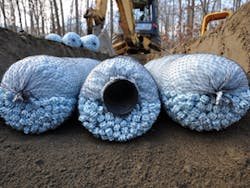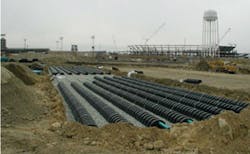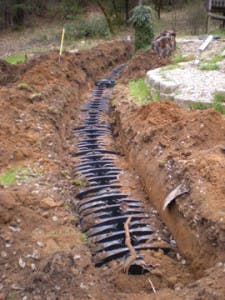The Use of Onsite Wastewater Treatment Systems in Concert With Water Reclamation and Reuse
Onsite Wastewater Treatment Partners With Reuse
A serious problem faces our society as the demand for potable water begins to exceed the available supply. Treating and reusing wastewater is becoming an acceptable solution to this problem. Engineers across the country are challenged to deliver cost-effective wastewater treatment and reuse solutions that protect the public health. Many of the solutions being developed are novel approaches. In the absence of sewers, onsite wastewater treatment systems are being designed to allow high water usage facilities to reuse wastewater. The systems discharge to the subsurface, thereby replenishing dwindling groundwater supplies, and the system designs incorporate treated wastewater as reuse for toilet flushing.
Classifications of Reused Water. The reuse of treated water relates to water that has been used for sanitary or industrial applications and then subjected to those treatment steps necessary to allow it to be reclaimed. Reuse can be classified as either indirect or direct. Indirect reuse occurs when the water receives enough treatment to be discharged back into the ground to build up the water table or prevent seawater encroachment. Direct reuse requires that the treated wastewater be transported directly to a point of reuse.
Treated or reclaimed wastewater is currently being reused for many purposes, including industrial and limited domestic applications. Some examples of this are recharging groundwater by directly injecting reclaimed water or allowing it to percolate into the ground, or irrigation for residential and commercial properties such as golf courses, farms, and firefighting.
Wastewater Treatment Systems for Water Reuse
In order for reclaimed sanitary wastewater to be acceptable to regulatory agencies and the general public, it has to meet very stringent treatment standards. In addition to the removal of conventional pollutants such as Total Suspended Solids and Biochemical oxygen demand (BOD), nutrients such as nitrogen and phosphorous may need to be reduced along with the removal of all waterborne pathogens, viruses, and any chemical compounds that impart color and odor. Since conventional secondary wastewater technology could not achieve these rigorous standards, it became necessary to apply advanced wastewater technology.
There are many acceptable technologies available for advanced wastewater applications, including tertiary systems that treat the effluent from conventional secondary systems and stand-alone advanced wastewater treatment systems. Nearly all of them require multiple steps to remove organics, nutrients, and ensure disinfection. A combination of technologies is used to treat and recycle the wastewater, which is often unique to the individual system and the requirements of state and local codes.
The Shallow Soil Horizon Is a Great Place for Treatment
There are many benefits to placing systems shallow in the soil. The foremost being that water is easily returned to the environment when closer to the point of origin. The upper soil horizons contain a more biologically active zone because it’s more aerobic. Here the oxygen is better diffused through the soil, increasing the number of organisms in comparison to deeper soils, which enhances the quality of treatment. These systems also meet minimum separation distances to groundwater or limiting layers such as bedrock or hardpan, satisfying regulations. Shallow systems fall in the root zone where plants can uptake water and nutrients. This uptake of water and the natural soil evaporation allow for evapotranspiration to occur. Evapotranspiration (ET) is a critical factor because in many soil conditions the permeability is very limited so the ET increases the capacity of the system while also providing better treatment by the root uptake of nutrients.
Shallow Applications That Can Be Applied to Reuse Designs
In order to reclaim wastewater, it is necessary for the designer to consider the wastewater treatment system and the treated wastewater disposal system. One challenge has been developing system designs and products that can provide substantive treatment at varying depths including shallow systems. These systems are often needed when groundwater levels are an issue or soils are poor. With the new approaches to system design and a number of technological advances, solutions for shallow system designs are expanding.
The availability of products for shallow applications is not new. Driplines have been around for years and have been installed in these designs. The choices have expanded recently to include other technology to meet the increasing demand.
Driplines deliver effluent into the biologically active soil horizon. Because they are installed at these shallow depths, the soil easily breaks down the effluent, while the plants, trees, and grass use the effluent and the nitrogen and phosphorus in it for nutrition. These two elements are the key components of most plant fertilizers. In this scenario, the wastewater is reused as a supplement or replacement for any plant irrigation and nutrition. Any remaining effluent is treated by the soil and returned to the groundwater supply. The typical drip line system uses a hydraulic delivery system for accurate pressure compensation and includes a free-floating diaphragm that cleans itself during operation. The drippers are generally located every 2 feet in the 1,000-foot rolls and provide 0.61 gallons per hour per emitter. In most applications, the tubing is placed 2 feet on center providing one emitter for every 4 square-feet of total area.
Plastic chambers are extremely effective in providing even distribution of effluent to the soil, and recent low-profile product innovations are making them a viable choice for shallow systems. Chamber systems are easy to install and are engineered for strength and performance. They offer a great deal of design flexibility, and, like driplines, they do not require heavy equipment for installation. This results in cost savings on labor, materials, and time savings on the job. One example, the Quick4 Plus Low Profile Chamber from Infiltrator Systems Inc., is only 8-inches tall and 4-feet long, making it ideal for difficult site configurations.
Reuse in Action
Case Study–Gillette Stadium, Foxborough, MA. The stadium that serves as the home of the NFL New England Patriots has the distinction of having one of the largest recreational water reuse systems. When the Town of Foxborough advised the private developers that constructed the stadium that they could not furnish enough water or treat the wastewater from the planned 68,000-seat stadium, it became apparent that the reuse of reclaimed water was the only answer.
Working closely with the Town, a program was developed to support the stadium that resulted in the construction of the following facilities:
- 250,000-gallon-per-day (MGD) membrane bioreactor facility capable of being expanded to treat 1.1 MGD
- 680,000-gallon equalization tank to capture the half-time wastewater surge
- 2.4-acre groundwater chamber recharge field for the excess highly treated effluent
- 500,000-gallon elevated water tank for reclaimed water storage
Key System Considerations
Water Supply. Today, Gillette Stadium and its environs serve as a venue for football games, soccer matches, concerts, and other public events. At the time of design, the Town of Foxborough did not have a sufficient enough water supply to meet demand during football games. Conventional solutions for supplying the stadium and other events concurrently were financially prohibitive. In order to meet the demand for water, engineers proposed to incorporate a water reclamation scheme into the design. The design would allow wastewater from the stadium and the community to be collected, treated, and reused for such purposes as toilet flushing, irrigation, cooling water, and flushing of streets and sidewalks.
Sewage Treatment. Had water been available, the existing sewer interceptor could not have managed to transfer the volume anticipated from the stadium to the wastewater treatment facility. The distance to the sewage treatment plant from the proposed stadium site made it cost-prohibitive. In addition, there was no nearby receiving water capable of accepting the high flows if a treatment plant was constructed to service the stadium.
The Foxborough Solution
The solution to Foxborough’s problem was to capture the wastewater from the stadium, treat it to a high degree, and store it for reuse when necessary. The treatment process is
based upon the application of membrane bioreactor technology. These reactors allow the organic wastes (including ammonia) to be biologically degraded by microorganisms, minimizing the need for excess power or chemicals. The solids in the treated wastewater are separated from the liquid fraction by membranes whose pores are small enough to capture viruses. Additional treatment is provided to biologically convert the nitrates formed from the destruction of the ammonia to nitrogen gas. The treated water is reaerated and disinfected using ultraviolet radiation, eliminating the discharge of bacteria. The community keeps the treated water aerated and stored for use at the stadium or elsewhere, if necessary. Excess water is discharged below the surface of the parking lot by a series of Infiltrator Chamber Beds, allowing recharge of the local aquifer.
In Conclusion
Science tells us that based upon the water cycle the earth has the same amount of water today that it always had. But we should be aware that we are wasting this limited resource when we use freshwater, treat the resulting wastewater to remove contaminants, and then discharge it to receiving water where it drains into the ocean and becomes unavailable for reuse. In comparison, reclaimed water that is treated according to today’s rigorous standards may be as good as raw water and suitable for reuse for many applications that do not involve direct human consumption.
Ever-changing regulatory requirements, intensified environmental sensitivity, and goals for sustainable development are pushing everyone in the wastewater industry to look for innovative approaches and products to better protect our public health and to conserve water with cost-effective methods to treat wastewater. Returning water to the aquifer as close to its origin as possible and cutting costs is driving the shift toward the use of onsite septic system treatment, as compared to centralized treatment plants. With the advanced products and new approaches now available, these natural systems are extremely efficient and effective, including those installed in the shallow soil horizons.




